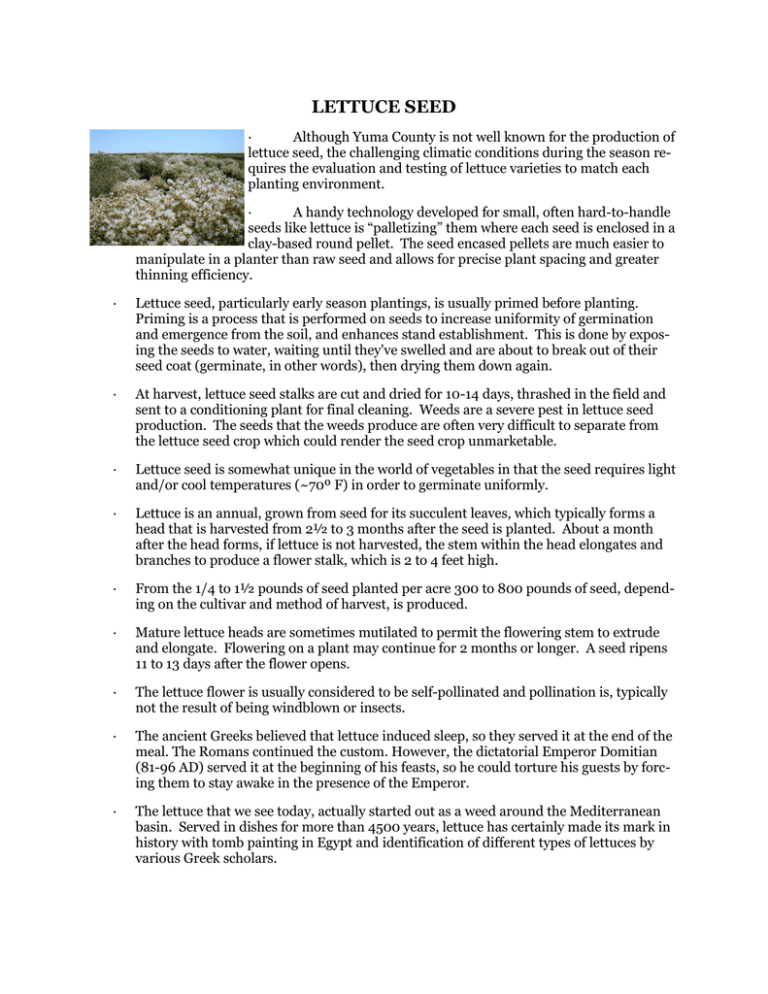LETTUCE SEED
advertisement

LETTUCE SEED · Although Yuma County is not well known for the production of lettuce seed, the challenging climatic conditions during the season requires the evaluation and testing of lettuce varieties to match each planting environment. · A handy technology developed for small, often hard-to-handle seeds like lettuce is “palletizing” them where each seed is enclosed in a clay-based round pellet. The seed encased pellets are much easier to manipulate in a planter than raw seed and allows for precise plant spacing and greater thinning efficiency. · Lettuce seed, particularly early season plantings, is usually primed before planting. Priming is a process that is performed on seeds to increase uniformity of germination and emergence from the soil, and enhances stand establishment. This is done by exposing the seeds to water, waiting until they've swelled and are about to break out of their seed coat (germinate, in other words), then drying them down again. · At harvest, lettuce seed stalks are cut and dried for 10-14 days, thrashed in the field and sent to a conditioning plant for final cleaning. Weeds are a severe pest in lettuce seed production. The seeds that the weeds produce are often very difficult to separate from the lettuce seed crop which could render the seed crop unmarketable. · Lettuce seed is somewhat unique in the world of vegetables in that the seed requires light and/or cool temperatures (~70º F) in order to germinate uniformly. · Lettuce is an annual, grown from seed for its succulent leaves, which typically forms a head that is harvested from 2½ to 3 months after the seed is planted. About a month after the head forms, if lettuce is not harvested, the stem within the head elongates and branches to produce a flower stalk, which is 2 to 4 feet high. · From the 1/4 to 1½ pounds of seed planted per acre 300 to 800 pounds of seed, depending on the cultivar and method of harvest, is produced. · Mature lettuce heads are sometimes mutilated to permit the flowering stem to extrude and elongate. Flowering on a plant may continue for 2 months or longer. A seed ripens 11 to 13 days after the flower opens. · The lettuce flower is usually considered to be self-pollinated and pollination is, typically not the result of being windblown or insects. · The ancient Greeks believed that lettuce induced sleep, so they served it at the end of the meal. The Romans continued the custom. However, the dictatorial Emperor Domitian (81-96 AD) served it at the beginning of his feasts, so he could torture his guests by forcing them to stay awake in the presence of the Emperor. · The lettuce that we see today, actually started out as a weed around the Mediterranean basin. Served in dishes for more than 4500 years, lettuce has certainly made its mark in history with tomb painting in Egypt and identification of different types of lettuces by various Greek scholars. · Christopher Columbus introduced lettuce to the new world and from there, lettuce in the United States began cultivating. Lettuce was introduced to the New World from Europe, as early as 1494. Thomas Jefferson had 19 varieties of lettuce growing in his garden at Monticello. · Iceberg lettuce got it's name from the fact that California growers started shipped it covered with heaps of crushed ice in the 1920s. It had previously been called Crisphead lettuce. · Lettuce (of all types) is the second most popular fresh vegetable in the United States behind #1 potato. The average American eats approximately 30 pounds of lettuce each year, which is five times what was eaten in 1900. · Lettuce is a vegetable that is pretty much immune to any form of preservation. You can't freeze it, can it, dry it, or pickle it. · While accumulating a worldwide gene pool of lettuces, the USDA found red, yellow varieties, and blue-green varieties of lettuce. · The expression 'rabbit food,' referring to lettuce, was first recorded in the 1930s. · There are 4 main types of lettuce: BUTTERHEAD - Loose heads, grassy green leaves, butter texture, mild flavor. CRISPHEAD - The least nutritious of the salad greens, this pale green lettuce takes on the cabbage appearance with its leaves more tightly packed together. LEAF - This variety doesn’t grow to form lettuce heads, but is instead the leaves are joined at the stem. ROMAINE - This lettuce has gained tremendous popularity in the past decade as the key ingredient in Caesar salads. It has a loaf-like shape with darker outer leaves. It’s strong taste and crispy texture has been favored by those who like Iceberg lettuce. · Ever hear of lettuce soup? It’s made out of chopped lettuce, water, salt, sugar, milk, butter and onion. · Lettuce maturity is based on head compactness. A compact head which can be compressed with moderate hand pressure is considered ideal maturity. A very loose head is immature and a very firm or hard head is over mature. Heads that are immature and mature have much better flavor than over mature heads and also have fewer storage problems. · Lettuce leaves consist of 95% water by weight. This is what makes the lettuce crisp. The cells high in water press against each other, producing the crunchy texture that is so desirable in the fresh leaves. · Lettuce, a member of the sunflower family, is one of the oldest known vegetables. · As everyone knows, lettuce makes a great base for a healthful salad. There are over 30 different varieties of ready-to-eat salads in the refrigerated section of the produce department in your local supermarket. Just open the bag and pour it in a bowl. Lettuce is also fun to use as a wrap. Add grilled chicken and salsa for a healthy entrée. · Lettuce also dresses up any sandwich. Include crisp iceberg for crunch or red leaf for a beautiful color. Kurt Nolte is an area agriculture agent with the Yuma County Cooperative Extension. He can be reached at 928-726-3904.


